Michelle Remembers and the Satanic Panic
The final installment in our three-part series about stories of abuse in minority religious communities and how they have influenced American culture
About This Series: Abusing Religion, Part 3
My book, Abusing Religion (Rutgers University Press, forthcoming July 2020), looks at stories about abuse in American minority religious groups. These stories share a common thread: they depict the violation of white American women and children at the hands of religious minorities. And they have inspired massive — indeed, staggeringly disproportionate — responses from the American public through law enforcement, media coverage, targeted legislation, and congressional actions.
This series for the Revealer introduces three stories of abuse in minority religious communities, how they caught the public’s attention, and why they still shape Americans’ thinking about religion and sexual violence. The first installment traced links between Mormon fundamentalists, Jon Krakauer’s Under the Banner of Heaven, and the American public’s fascination with polygyny.[1] The second considered American Muslims, race, and the “Not Without My Daughter problem.” This final piece explains how Michelle Remembers, a fantastic tale about one girl’s battle with Satan, ignited a global moral panic over religious difference and child sexual abuse.[2]
***
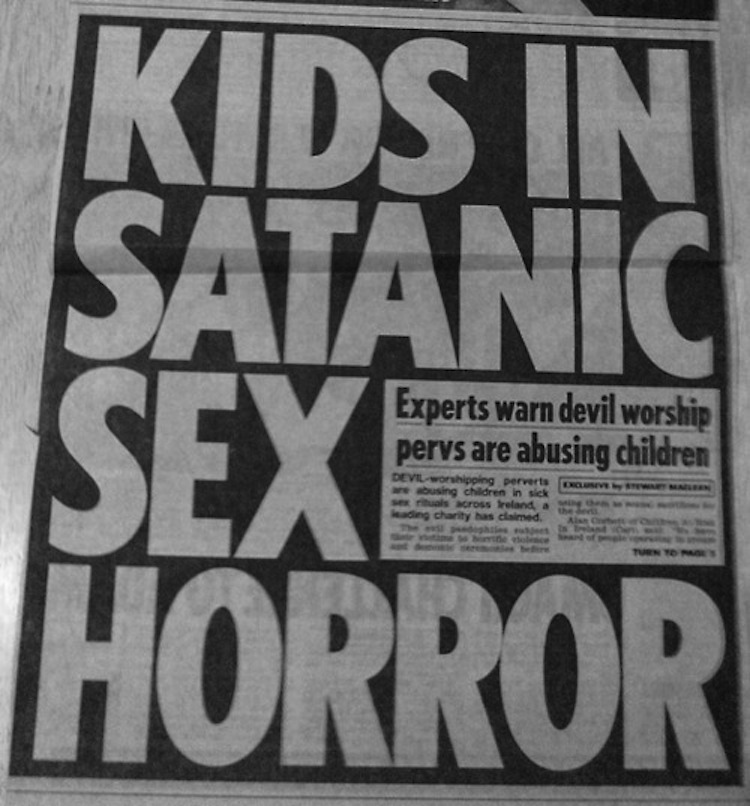 In the 1980s and early 1990s, psychologists, law enforcement officials, nationally syndicated talk show hosts, and at least one sitting U.S. senator[3] believed Satanists were corrupting our nation’s youth through predatory childcare centers, encrypted rock music, and tabletop gaming systems that could serve as literal gateways to hell.
In the 1980s and early 1990s, psychologists, law enforcement officials, nationally syndicated talk show hosts, and at least one sitting U.S. senator[3] believed Satanists were corrupting our nation’s youth through predatory childcare centers, encrypted rock music, and tabletop gaming systems that could serve as literal gateways to hell.
No, really.
Americans who did not live through the 1980s might be surprised to learn about our country’s decade-long, nationwide fascination with the occult, but it did happen.
There was widespread anxiety about sinister influences infiltrating childcare facilities, schools, the entertainment industry, and all levels of government. At the height of this moral panic, many otherwise-average Americans suspected wealthy and powerful figures of nefariously conspiring to abuse and abduct our nation’s youth for pornography, prostitution, and ritual sacrifices.[4]
The FBI spent nearly a decade and almost a million dollars investigating allegations that led to the so-called Satanic Panic – only to conclude that no evidence of satanic ritual abuse existed. How, then, could so many have been convinced of a global plot to harm children and recruit them to Satan’s service? Experts point to the publication of one woman’s recovered memories of abuse, Michelle Smith and Lawrence Pazder’s Michelle Remembers, as the origin point for America’s pernicious paranormal paranoia.
Pazder and Smith promoted Michelle Remembers across North America, led workshops for law enforcement, mental health providers, and social workers, and sparked a fear of Satan into the hearts of millions of Americans. This demonic phenomenon is seldom acknowledged today, much less recognized as a watershed in the history of American religions.[5] To understand how a Satanic Panic swept the nation only to be swept under the rug a few decades later, it’s important to know a bit about the political, religious, and popular culture landscape of the 1980s and early 1990s.
SATANIC PANIC
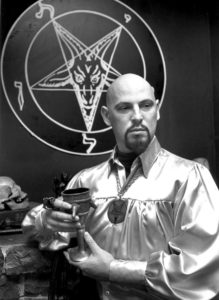
Anton LaVey
It’s no coincidence that Americans became fixated on cosmic struggles between Good and Evil in the 1980s. The 1960s and 1970s saw a dramatic spike in American religious innovation, including the emergence of many new religious movements (which outsiders often denounced as “cults”). These innovative religious groups included confessional Satanists, among which both Anton LaVey’s Church of Satan and its breakaway counterpart, Michael Aquino’s Temple of Set, were known for their publicity-grabbing antics.[6]
Unsurprisingly, religious Satanism was met with strenuous public opposition from conservative Christians – many of whom were building coalitions to flex unprecedented religious influence in the American political arena. As the New Christian Right, many conservative, primarily white Christians set themselves against what they perceived as national moral decline. They believed evil was at work in the world, evidenced in behaviors like unrepentant queerness, seeking access to contraception and abortion, working out of the home while female, and exhibiting a suspicious fondness for rock music or role-playing games, among other threats to national security.
We can see this Good (read: white conservative Christian) v. Evil (read: everyone else) mentality at work in Reagan’s “Evil Empire Speech” to the National Association of Evangelicals. These remarks include Reagan, whose election owed much to white conservative Christian politicking, calling the then-Soviet Union an “evil empire” and describing the tension between the US and the USSR as “the struggle between right and wrong and good and evil.” Reagan’s rhetoric reflected broader trends in New Christian Right fearmongering: televangelists Pat Robertson and Jerry Falwell spoke of American Christians “fighting a holy war,” while author Hal Lindsey warned that Satan Is Alive and Well on Planet Earth. But concerns about demonic assaults on the American family were by no means limited to the New Christian Right or even solely to confessed Christians.
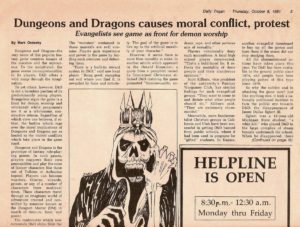 The Satanic Panic was a broad and pervasive cultural anxiety about the (presumably secular) interests, inclinations, and activities of young Americans. High-profile talk shows and nightly news programs warned parents about the dangers of hard rock and heavy metal music, commonly thought to contain “backmasked” messages that, when played in reverse, would encourage listeners to hail Satan. The popularity of tabletop gaming systems like Dungeons and Dragons was likewise suspect, as news programs like 20/20 cautioned that such games might actually be “intense occult training.” For many late twentieth century Americans, Evil was not an abstract ethical concept. Evil was a material reality, and it was coming for their kids.
The Satanic Panic was a broad and pervasive cultural anxiety about the (presumably secular) interests, inclinations, and activities of young Americans. High-profile talk shows and nightly news programs warned parents about the dangers of hard rock and heavy metal music, commonly thought to contain “backmasked” messages that, when played in reverse, would encourage listeners to hail Satan. The popularity of tabletop gaming systems like Dungeons and Dragons was likewise suspect, as news programs like 20/20 cautioned that such games might actually be “intense occult training.” For many late twentieth century Americans, Evil was not an abstract ethical concept. Evil was a material reality, and it was coming for their kids.
At the same time, 1980s America also saw a sharp uptick in concern about child welfare, especially geared toward the prevention of child sexual abuse. Child abuse became a national issue in the early 1960s: both Newsweek and Time published stories on the domestic abuse of children in 1962; that same year, Congress amended the Social Security Act to include the first federal provisions for child protection.[7] Child sexual abuse would not garner substantive national attention until the late 1970s; according to sociologist David Finkelhor, “between 1977 and 1978 almost every national magazine had run a story highlighting the horrors of children’s sexual abuse.”[8]
But it was not until the 1980s that American media coverage and activist outreach began a sustained conversation about acknowledging and preventing the sexual abuse of children. Child abuse reports nearly doubled from the 1970s to the 1980s; this decade saw significant governmental and cultural resources directed toward the prevention of child sexual abuse.[9] Strangely, awareness and funding of these efforts owed much to the publication and dissemination of Michelle Smith’s account of surviving satanic ritual abuse, as presented in her book Michelle Remembers. Americans of the 1980s, it seems, were ready to credit and respond to accounts of child sexual abuse – so long as the alleged perpetrators were demonic cultists like the ones Smith “remembered.”
WHY MICHELLE MATTERS
Michelle Remembers (1980) was the earliest and most influential narrative of satanic ritual abuse. It is a firsthand account of how Michelle “Smith” survived captivity, torture, and molestation by a group of devil-worshipping cultists, including her mother, a local coven led by a man named Malachi, and the “Church of Satan.”[10] Smith “recovered” her memories of these atrocities under the guidance of her coauthor, therapist, and eventual husband, Dr. Lawrence Pazder. [11] Michelle Remembers would eventually sell hundreds of thousands of copies. Following the book’s publication, Smith and Pazder emerged as the world’s foremost specialists in satanic ritual abuse.
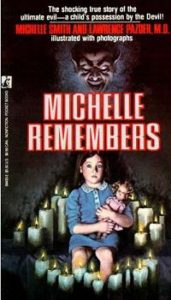 Scholars are nearly unanimous in identifying Michelle Remembers as the spark that lit the torches Americans would carry against their imaginary demonic foes. Pazder and Smith travelled across North American to promote their work, giving radio interviews and appearing on television talk shows, including The Oprah Winfrey Show, Donahue, Geraldo, and 20/20. The authors directed seminars for mental healthcare professionals, who in turn diagnosed hundreds of women with ritual abuse-related maladies.
Scholars are nearly unanimous in identifying Michelle Remembers as the spark that lit the torches Americans would carry against their imaginary demonic foes. Pazder and Smith travelled across North American to promote their work, giving radio interviews and appearing on television talk shows, including The Oprah Winfrey Show, Donahue, Geraldo, and 20/20. The authors directed seminars for mental healthcare professionals, who in turn diagnosed hundreds of women with ritual abuse-related maladies.
Pazder and Smith’s efforts to publicize their work directly contributed to the proliferation of satanic ritual abuse allegations. As Robert Hicks of the US Justice Department noted in a 1990 interview: “before Michelle Remembers there were no [s]atanic prosecutions involving children. Now the myth is everywhere.”[12] Pazder and Smith trained social workers and law enforcement officers to look for satanic crimes, providing informational materials and leading workshops that popularized ritual abuse as a motive in hundreds of criminal investigations.
Pazder and Smith also served as expert witnesses on numerous — Pazder claimed upwards of one thousand — cases of alleged child ritual abuse. Smith gave expert testimony and guided psychological evaluations of children who, under intense interrogation by prosecutors and psychologists persuaded by Pazder and Smith’s work, bore witness to satanic ritual abuse. The most infamous of these cases was the McMartin Preschool Trial, which numbers among the longest and most expensive criminal trials in American history.
There was nothing of Satan in the allegations that inspired the initial McMartin Preschool inquest. Before Smith and Pazder involved themselves in the case, the McMartin parents primarily focused their allegations that Raymond Buckey had sexually assaulted one or more of the children enrolled at McMartin Preschool. But the case started receiving national attention in February 1984 – at which point Pazder and Smith offered their services, and the children’s testimony became decidedly demonic. Michelle Remembers and its authors shaped investigators’ questions, prosecutors’ agendas, and the public’s understanding of the case specifically in terms of ritual abuse.[13] Childcare professionals like Virginia McMartin, her daughter, and her son-in-law found themselves facing extensive and devastating lawsuits accusing them of abusing their charges for diabolical reasons.
McMartin became the first of more than one hundred cases in which children alleged coercion into “devil worship, open graves, cannibalism, airplane trips, nude photography, being urinated or defecated on, and murdering babies.”[14] McMartin and her family all vehemently denied having abused the children in their care.[15] No material evidenced ever surfaced to corroborate their child-accusers’ accounts.[16]
There is likewise no evidence to support Smith’s memories of being ritually abused by her mother or the Church of Satan.[17] Church of Satan founder and high priest Anton LaVey threatened the authors with a lawsuit for libel following the publication of Michelle Remembers. (Pazder withdrew the allegation.) The book is also riddled with inconsistencies. Maclean’s, a popular Canadian magazine, published a scathing debunking shortly after Michelle Remembers’ release, in which Smith’s father and sisters challenged and denounced Smith’s memories. But attempts to discredit the authors did little to diminish the work’s popularity – and their continued influence in law enforcement and mental health circles lent credibility to otherwise unbelievable accusations.[18]
AFTER MICHELLE
Fears of satanic machinations in American schools, daycare facilities, homes, and seats of government spread like wildfire throughout the 1980s. Many women publicly identified with Smith’s memories of ritual abuse, resulting in the publication of more than fifty first-person accounts of satanic ritual abuse, beginning in the late 1980s and continuing to this day.[19] The 1988 edition of The Courage to Heal, a popular self-help book most recently republished in 2008, suggested abuse survivors might repress traumatic memories only to recover them later in life, often with the help of a mental health professional. This version—and only this version—of The Courage to Heal also includes suggestions from “cult cop” Sandi Gallant on how to recognize satanic ritual abuse; Gallant identifies Pazder as the foremost expert on the ritual abuse phenomenon.
Despite widespread credence lent to these kinds of accusations, no evidence emerged to corroborate a single accusation of satanic ritual abuse. After eight years and $750,000 of taxpayer money, federal investigator Kenneth V. Lanning reported in 1992 that he could find no evidence of ritual abuse in the United States. Lanning expressed concern that the Satanic Panic would compromise the credibility of children’s sexual assault allegations and outrage that “individuals are getting away with molesting children because we cannot prove they are satanic devil worshipers who engage in brainwashing, human sacrifice, and cannibalism as part of a large conspiracy.”
This is one of the most challenging aspects of studying Michelle Remembers’ legacy: A ludicrous, unproveable story drew unprecedented and much needed attention to the crisis of child sex abuse. As Louise Armstrong notes in Rocking the Cradle of Sexual Politics, “it may have taken satanic images and triple sixes and cannibalized infants and pentagrams and chanting from the Dark Side—but we’d finally gotten the sense of something bad going on.” At the same time, the Satanic Panic diverted blame for child sex abuse away from its proven perpetrators—family members and acquaintances—onto a demonic global conspiracy. Or, as Armstrong puts it: “you could also look at it this way: the tormenting and raping of children by ordinary familial human agency just hadn’t been bad enough.” Despite an absolute absence of evidence, accusations of satanic ritual abuse had startling tenacity. In fact, attempts to debunk these accusations often led to further dissemination of the accusations – as is often the case with conspiracy theories.
Journalists and therapists who expressed skepticism about a global conspiracy that used animal mutilations, infant sacrifice, and child sex abuse faced ridicule and threats. Families of people who recovered memories of ritual abuse—mistakenly, it would now seem—were ripped apart. Hundreds of people accused of satanically-motivated crimes spent decades imprisoned under false pretenses and went bankrupt trying to prove their innocence.
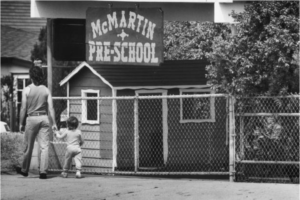 In the wake of the McMartin Preschool trial, hundreds of other daycare workers were interrogated and dozens convicted for ritual abuse-related crimes, the only evidence for which was the coerced testimony of young children. Notably, in the cases of Kelly Michaels, Bernard Baran, and the San Antonio Four, a group of Texas women who spent nearly 15 years in prison following wrongful felony convictions for child sexual assault after a trial in which the prosecution cited the defendants’ homosexuality as further support for the accusations of ritual abuse. They were not released until 2016 and did not have their criminal records expunged until December 2018. The Satanic Panic might be over, but its memory continues to haunt the American political landscape.
In the wake of the McMartin Preschool trial, hundreds of other daycare workers were interrogated and dozens convicted for ritual abuse-related crimes, the only evidence for which was the coerced testimony of young children. Notably, in the cases of Kelly Michaels, Bernard Baran, and the San Antonio Four, a group of Texas women who spent nearly 15 years in prison following wrongful felony convictions for child sexual assault after a trial in which the prosecution cited the defendants’ homosexuality as further support for the accusations of ritual abuse. They were not released until 2016 and did not have their criminal records expunged until December 2018. The Satanic Panic might be over, but its memory continues to haunt the American political landscape.
Consider, for example, Pizzagate: the viral 2016 election cycle conspiracy theory that high-ranking members of the Clinton campaign were trafficking children through D.C. area pizzerias. (Again: really.) The D.C. Metropolitan Police Department thoroughly refuted Pizzagate, but disinformation from InfoWars, YouTube videos, and reddit threads (as well as convicted felon and former National Security Advisor Michael Flynn) spread this theory relentlessly. In December 2016, Edgar Maddison Welch fired an assault rifle into the Comet Ping Pong Pizzeria in response to Pizzagate fearmongering. Thousands of others like Welch remained convinced that DC pizza restaurants are trafficking kids. Comet Ping Pong still receives threatening phone calls about their supposed trafficking activities. With its lurid and incredible tales of children captured and subjected to unspeakable sex abuse, Pizzagate has inspired several think pieces on the legacy of the Satanic Panic.
These kinds of “strange, fevered imaginings,” like Pizzagate and the Satanic Panic, seem almost too incredible to believe – but they do happen. Shots are fired, people are imprisoned, families are destroyed because of the American public’s misplaced and willfully misinformed convictions that we abuse children, not in normal mainstream American households, but in the dark, shadowy recesses of our nation’s underbelly.
Michelle Remembers was that rarest of tales: a story about child sex abuse that is not only believed but inspires massive action to identify and prevent further sex abuse from happening. It is telling that a story involving the physical appearance of Satan himself seemed so credible to so many American readers, while hundreds of less fantastic accounts of sexual abuse go ignored for decades.
This case study, and Abusing Religion as a whole, asks us to consider which stories about abuse we believe, and more importantly, which stories about abuse we choose to act upon. As a nation, we protect ourselves (or think we do) by telling ourselves stories about what happens when we do sex and religion wrong. These kinds of stories make us feel safe, because—incredibly—it’s easier to believe in a global satanic conspiracy than to confront our own relatives, partners, and acquaintances as abusers.
Sex abuse is an American problem, not (merely) a religious one. The problem of religious sex abuse is so much bigger than religion. Religious belonging can make abusive situations and relationships harder to escape. Religion can make it harder to recognize abuse as such. Religious communities frequently protect abusers while denying and enabling abuse, creating conditions of possibility for abuse, allowing abuse to flourish.[20] But religion does not cause abuse.
Abuse is not something that only happens on the margins of our society. It happens everywhere. It happens always. It can happen to any of us—though some of us are more likely to be believed, more likely to survive abuse than others. We need to stop blaming abuse on religion, on anything other than people being willing to exploit other people’s vulnerabilities. We need to ask ourselves why only certain stories inspire action, and resist stories that make us feel safe because we imagine it could not happen to us.
***
[1] Polygamy refers to any marriage of multiple partners and is the most common term used by outsiders to describe Mormon fundamentalist plural marriage. But Mormon fundamentalist plural marriages are exclusively polygynist, marriages of one man to multiple women. Mormon fundamentalist doctrine permits — and in some cases encourages — this form of “plural marriage” while proscribing polyandry, the marriage of one woman to multiple men. See Doctrine and Covenants 132: 54-55.
[2] “Moral panic” refers to an intense public reaction to an issue or group perceived to threat a culture’s social order. Stanley Cohen’s Folk Devils and Moral Panics in particular has shaped my understanding of these phenomena.
[3] Spoilers: it was Jesse Helms. In 1985, he played the entirety of 20/20’s “The Devil Worshippers: Exposing Satan’s Underground” for the US Senate in an attempt to ensure Congress would allot no federal funds nor afford tax-exempt status to “any cult, organization, or other group that has a purpose, or that has any interest in, the promoting of satanism or witchcraft.” See Senator Helms speaking on HR 3036, 99th Cong., 1st sess., Congressional Record 131 (September 26, 1985): S 25077–25080.
[4] And some less ordinary Americans as well, including Joan Baez, who released an album and title track entitled “Play Me Backwards,” in reference to the ritual abuse scare; and Gloria Steinem, who donated to the McMartin Preschool investigation. Ms. Magazine, founded by Steinem, also ran a cover story called “Believe It! Cult Ritual Abuse Exists” in their January/February 1993 edition (though this volume is not available for purchase in the Feminist Majority’s archive).
[5] There are exceptions, of course: see Maurice Chammah’s work for the Marshall Project and Gary Cartwright’s 2009 update to his 1994 Texas Monthly article on Fran and Dan Keller, as well as Michael Hall’s “Hysteria” (2009, Texas Monthly).
[6] Not to be confused with the Satanic Temple, which publicly advocates for reproductive justice and state disestablishment.
[7] “When They’re Angry,” Newsweek, April 16, 1962; “Battered Child Syndrome,” Time, July 20, 1962.
[8] Content warning for explicit descriptions of child sexual abuse in Sexually Victimized Children, as you might imagine.
[9] This widespread concern about child abuse prevention is, by the way, why Big Bird’s historically imaginary friend Mr. Snuffleupagus became visible to Sesame Street’s non-avian residents in 1985: the show’s creators and producers worried a storyline that portrayed grownups not believing children might make think twice about reporting abuse. Illinois Public Media’s television program director conjectures that the show’s executive producer might have been directly responding to the McMartin Preschool Trial, but I’ve been unable to find further corroboration on this.
[10] Smith’s legal surname was Proby until she and Pazder divorced their respective spouses and married each other. The events Smith recalled would have taken place in 1954; Anton LaVey did not found the the Church of Satan until 1966.
[11] Psychogenic amnesia (better known as repressed memories) is a condition under which the patient suppresses traumatic memories. Psychiatric professionals are now more likely to diagnose patients with “false memory syndrome,” a condition often caused by repressed memory therapy that produces “memories” of events that never occurred.
[12] Allen and Midwinter, “Michelle Remembers: The Debunking of a Myth.”
[13] Police reports show that Pazder was convinced of a massive international satanic conspiracy: “anybody could be involved in this plot,” Pazder insisted, “including teachers, doctors, movie stars, merchants, even…members of the Anaheim Angels baseball team.” Ellis, Raising the Devil, 117.
[14] Wright, Remembering Satan, 73.
[15] Ibid., 40-1.
[16] Ibid., 116.
[17] While Smith’s “recovered” memories did not play a key role in the McMartin trial, by the end of the decade numerous women would claim to have recovered similar memories. Like Smith, these women recovered/created memories of satanic ritual abuse at the direction of mental health professionals – usually to their detriment. Relatively few psychologists and psychiatrists diagnosed patients with ritual abuse-related maladies. But those few therapists were responsible for hundreds of diagnoses, and their criteria for these diagnoses followed a script set by Smith, Pazder, and Michelle Remembers. See Goodwin, “They Couldn’t Get My Soul: Recovered Memories, Ritual Abuse, and the Specter(s) of Religious Difference.”
[18] Allegations included charges that McMartin employees had forced children in their care to participate in “the ritualistic ingestion of feces, urine, blood, semen, and human flesh; the disinterment and mutilation of corpses; the sacrifices of infants; and the orgies with their day care providers, costumed as devils and witches, in the classrooms, in tunnels under the center, and in car washes, airplanes, mansions, cemeteries, hotels, ranches, gourmet food stores, local gyms, churches, and hot air balloons.” de Young, “The Devil Goes to Day Care,” 21.
[19] Most of these come through cottage or vanity presses; many are of part of the growing industry in Christian “spiritual warfare.” But a handful have been published by credible scholarly presses, including the University of Toronto, Routledge, and Lexington.
[20] Sarah Imhoff, “The Myth of Secular Law as Savior,” The Immanent Frame, February 12, 2019, https://tif.ssrc.org/2019/02/12/the-myth-of-secular-law-as-savior/.
***
Megan Goodwin (Ph.D. UNC 2014) is a scholar of gender, sexuality, race, politics, and contemporary American minority religions. She is the Program Director of Sacred Writes: Public Scholarship in Religion, a Luce-funded project hosted by Northeastern University, committed to amplifying the voices of experts who often go unheard in public discourse. Her current book project, Abusing Religion: Literary Persecution, Sex Scandals, and American Minority Religion (Rutgers University Press, forthcoming July 2020), explores the coding of religious difference as sexual danger. Her next project considers the ways contemporary American whiteness is (or feels) threatened by Muslims and Islam. Follow her on twitter at @mpgphd.
***
Published with support from the Henry R. Luce Initiative on Religion in International Affairs.